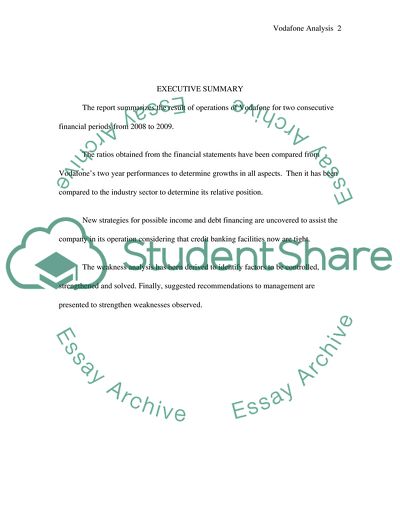Cite this document
(“Analysis of Financial and Operating Performance of Vodafone Assignment”, n.d.)
Analysis of Financial and Operating Performance of Vodafone Assignment. Retrieved from https://studentshare.org/finance-accounting/1560813-you-have-been-recenly-appointed-to-the-post-of-finance-director-of-vodafone-plcthe-executive-boaard-has-asked-you-to-presend-a-report-detailing-the-performance-of-the-company-for-the-last-two-years-and-recommend-ways-for-improvment-and-make-the-company-m
Analysis of Financial and Operating Performance of Vodafone Assignment. Retrieved from https://studentshare.org/finance-accounting/1560813-you-have-been-recenly-appointed-to-the-post-of-finance-director-of-vodafone-plcthe-executive-boaard-has-asked-you-to-presend-a-report-detailing-the-performance-of-the-company-for-the-last-two-years-and-recommend-ways-for-improvment-and-make-the-company-m
(Analysis of Financial and Operating Performance of Vodafone Assignment)
Analysis of Financial and Operating Performance of Vodafone Assignment. https://studentshare.org/finance-accounting/1560813-you-have-been-recenly-appointed-to-the-post-of-finance-director-of-vodafone-plcthe-executive-boaard-has-asked-you-to-presend-a-report-detailing-the-performance-of-the-company-for-the-last-two-years-and-recommend-ways-for-improvment-and-make-the-company-m.
Analysis of Financial and Operating Performance of Vodafone Assignment. https://studentshare.org/finance-accounting/1560813-you-have-been-recenly-appointed-to-the-post-of-finance-director-of-vodafone-plcthe-executive-boaard-has-asked-you-to-presend-a-report-detailing-the-performance-of-the-company-for-the-last-two-years-and-recommend-ways-for-improvment-and-make-the-company-m.
“Analysis of Financial and Operating Performance of Vodafone Assignment”, n.d. https://studentshare.org/finance-accounting/1560813-you-have-been-recenly-appointed-to-the-post-of-finance-director-of-vodafone-plcthe-executive-boaard-has-asked-you-to-presend-a-report-detailing-the-performance-of-the-company-for-the-last-two-years-and-recommend-ways-for-improvment-and-make-the-company-m.


